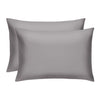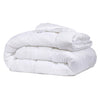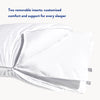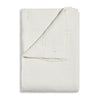The Daily Miracle
How to Do Laundry, the Right Way
Published
August 29, 2020
Author
Nicholas Crusie

Woah woah woah, we're not saying you aren't doing it the right way. But, how are you doing it?
Did your parents teach you before you went off to college? Did a roommate get fed up with you doing it incorrectly and give you a little lesson? Maybe you can't remember ever even being taught how to do it and you've just been winging it. It isn't as simple as it used to be.
We've come a long way from living in huts and taking our laundry down to the river with a washboard. We've even come a long way from what our grandparents were probably doing to keep their clothes clean. With all the fabrics, detergents, machines, and settings, there are a lot of variables to work with and things to remember. We're here to help.
You're probably wearing clothes right now as you sit here and read this, so clearly it's not an emergency and you're doing something right. But there is a right and wrong way to do laundry. Well, there are a few right and wrong ways. We want to go over them with you just to be sure that your clothes, bed sheets, and towels are being treated properly so they can continue to treat you properly.
Especially if you have special pieces that need some extra attention. Perhaps a fancy new top, your mom's old sweater, or maybe even your childhood blanket; we want to make sure they're all well taken care of. Let's make laundry mishaps a thing of the past. Here's your go-to guide for doing laundry, the right way.
Let's break this down!
Know the symbols
They may look like mad scientist symbols at first, but once you get to know them they aren't too bad. Some of these little guys are fairly easy to figure out but others may require some background research. Knowing the symbols and understanding how to read them is really important for avoiding any silly mishaps. The devil is in the details, and in this case, the symbols.
Here's a really great comprehensive guide to all the laundry symbols you could encounter. Thanks, Tide!
Read your labels
Don't overlook the care symbols and instructions that come on the tags of your clothing. Sometimes they will be on the tag from the store (be sure to read before you throw it away, or maybe take it off and save it in your laundry room) and sometimes it will be attached on the inside of the article.
The label will usually tell you information such as if the piece can be machine washed, what temperature of water to wash it in, and any other particular requirements it may have. Different fabrics like cotton, wool, and synthetics all react differently to different water temperatures and detergents.
This step may seem tedious, but if you just got yourself an expensive new suit or fresh fluffy towels, taking the time to read the label will help these items last longer and stay in the best condition possible.
Sort and separate
Sorting by color
- Separate lights and darks, paying particular attention to the whites.
- It seems to be rather controversial if we actually need to be doing this. Yes, the answer is yes. Separate your laundry by color. Your clothes will thank you.
- If you have enough whites to fill a load, you should ideally be doing whites completely on their own. The next best option is to give "lights" their own load. This can include whites, light grays, and soft pastels.
- The "darks," those deep and heavy colours like black, blues, and greens, should be done together and on their own.
Sorting by type of fabric
- Items like towels and bed sheets should be done separately from clothing.
- Towels are thicker and will wash and dry more slowly than clothing; this will make the cycles inefficient and can result in items staying damp. Any dampness left unattended will foster bacterial growth and odors - these side effects will be magnified if you forget about the laundry for a few hours. (It's ok - it happens to all of us).
- Same goes for bedsheets. Bedsheets are their own unique size and texture, thus affecting the way they should be washed. Most laundry machines will have a distinct setting for bedding.
New items
- New items should be washed solo the first time you bring them home - this will protect against the possibility of any colour running and getting onto anything else in the load.
Delicate vs. durable
- Ideally, we should also be sorting out the delicate fabrics from the sturdy ones. Machines have special settings for delicates that will be more gentle, avoiding any tears or threads coming loose.
Turn your clothing inside out
Turning your clothes inside out will help preserve their bright and vibrant color. By being inside out, the colors won't be rubbing against each other, avoiding wear and tear for the vibrance of color.
Use the right detergent
It's 2020 and the laundry detergent section in grocery stores is starting to look like the candy bar section in convenience stores - it can be overwhelming, we know. So we're going to keep it simple and give you the information you need to know so you can make your decision.
Liquid detergent is best for removing grease, oil, and food.
Powdered detergent is a good option for everyday loads when your clothes are simply dirty.
Single use packets, like pods, are the easiest to use but they're also usually the most expensive. Another drawback of pods is that you can't adjust the dosage depending on your soil level.
And of course there are the options like eco-friendly, fragrance-infused, scent-free, cold water wash, ultra. The list goes on. If you feel like getting fancy with it, go ahead and choose any of these specialities.
*Pro tip: Go easy on the detergent. Using too much, or even just the recommended amount, can leave residue which will make articles stiff. Erring on the light side of detergent dosage will help pieces like towels stay light and fluffy.
Know your machine settings
Water temperature
- Hot water - Hot water is best for removing tough stains and killing germs. Use hot water for whites, light colors, and bed sheets.
- Warm water - Warm water is good for cleaning clothes without fading them and there's less chance of shrinkage.
- Cold water - Cold water is the most gentle on clothing and saves energy. You can use cold water for dark colors, delicate fabrics, and anything you're worried about potentially shrinking.
Cycle
- Regular - Regular or normal setting is best for whites, sheets and towels, and anything that's particularly dirty.
- Delicate - Delicate cycle will be more gentle, making it ideal for any delicates as well as wool and silk.
- Permanent press - The permanent cycle is for everyday clothing like jeans, garments made of manmade materials like polyester, and any other non-cotton items.
Final check
This is the time to pretreat any stains and double-check pockets for any valuables or items that may come loose in the machine. Zip up any pockets and close buttons to make sure they won't catch onto other items and cause tears.
Everything can now be thrown into the wash - hit that start button.
Dry time
Hang Dry
- More gentle on clothing.
- Saves energy.
- If you have the space to hang dry your clothing, a case can be made for why it's worth the extra effort.
Machine dry
Make sure you're transferring garments from the washer to the dryer promptly - we don't want wet articles sitting in the washer as this increases the chance for bacterial growth, odor, and wrinkles.
Be sure to separate heavyweight from lightweight items to ensure everything dries evenly.
Different settings like regular, delicate, permanent press, and air dry are all pretty self explanatory. Assess the items that you'll be throwing in and make your choice accordingly.
A good rule of thumb is that most items are tumble dry low--you can check the care label for those symbols again to guide you! Just watch out for a box with a line in it--this means no dryer at all and it needs to lay flat to dry!
Folding
You should try to fold (or hang) the laundry right after it's finished drying to give it the best chance to stay wrinkle-free. Folding is also important to help save space in your closet and make things easy to identify and find when you need them.
Here's a comprehensive guide to folding clothes that might be coming out of the laundry. Pay attention to tips for items that might be trickier to fold properly, like jeans and collared shirts.
For tough non-clothing items, check out for our guide on how to fold fitted sheets, and here for our guide on how to fold towels. You're welcome!
There You Have It !
That's it! Laundry 101. That wasn't so bad, was it? Nothing to be scared of. There is a right way to do laundry. Keep caring for your clothes, sheets, and towels so they can keep caring for you.
 |
Did you know?Turning your clothes inside out will help preserve their bright and vibrant color. |
Sources:
- https://azcdn.galileo.pgsitecore.com/en-us/-/media/Tide/Images/Documents/pdf/Tide-Your-Guide-to-Decoding-Laundry-Symbols.pdf
- https://www.cleaninginstitute.org/cleaning-tips/clothes/stain-removal-guide
- https://www.thespruce.com/reasons-to-line-dry-laundry-2145997
- https://www.thespruce.com/how-to-fold-clothes-and-laundry-2146068


























